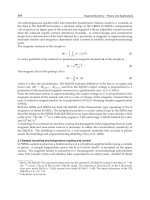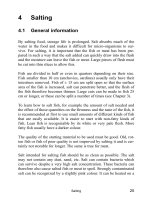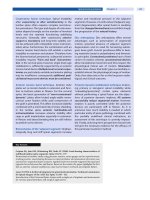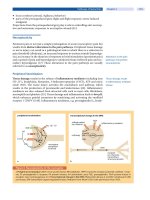High Temperature Strain of Metals and Alloys Part 12 docx
Bạn đang xem bản rút gọn của tài liệu. Xem và tải ngay bản đầy đủ của tài liệu tại đây (96.26 KB, 8 trang )
164 References
References
1. F. Garofalo, Fundamentals of Creep and Creep-Rupture in Metals, McMillan
Series in Materials Science, McMillan, New York, 1965.
2. D. McLean, The physics of high temperature creep in metals Rep. Progr.
Phys. 1966, 29,1.
3. A.J. Kennedy, Processes of Creep and Fatigue in Metals, Oliver & Boyd,
Edinburgh, 1967.
4. R.W.K. Honeykomb, The Plastic Deformation of Metals, Edward Arnold
(Publishers), Cambridge, 1968.
5. H.E. Evans, Mechanisms of Creep Fracture, Elsevier Applied Science Pub-
lishing, Amsterdam 1984.
6. J.
ˇ
Cadek, Creep in Metallic Materials, Materials Science Monographs,
vol. 48. Elsevier, Amsterdam 1988.
7. M.E. Kassner, M.T. Pèrez-Prado, Five-power-law creep in single phase
metals and alloys, Progr. Mater. Sci. 2000, 45, 1–102.
8. W. Blum, Creep of crystalline materials: basis, mechanisms and models,
Mater. Sci. Eng. A 2001, 319–321, 8–15.
9. N.F. Mott, A theory of work-hardening of metal crystals, Philos. Mag.
1952, 43 (346), 1151–1177.
10. J. Weertman, Theory of steady-state creep based on dislocation climb, J.
Appl. Phys. 1955, 26 (10), 1213–1217.
11. C.R. Barrett, W.D.Nix,Amodelforsteady-statecreepbasedonthemotion
of jogged screw dislocations, Acta Metall. 1965, 13 (12), 1247–1258.
12. R. Lagneborg, Development and refinement of the recovery-creep theory,
Met. Sc. J. 1969, 63, 161–168.
13. V.V. Levitin, V.I. Babenko, Installation for X-ray investigations of metal
specimens; the author’s certificate no 251894, J. Inventions 1989 28, 12.
14. M.A. Darvin, The reflexion of X-rays from imperfect crystals, Philos. Mag.
1922, 46 (257), 800–809.
15. P. Gay, P.B. Hirsh et al., The estimation of dislocation densities in metals
from X-ray data, Acta Metall. 1953, 1 (3), 315–328.
16. P.B. Hirsch, A. Howie et al., Electron Microscopy of the Thin Crystals, But-
terworths, London, 1965.
17. V. Levitin, Atom Vibrations in Solids: Amplitudes and Frequencies, Cam-
bridge Scientific Publishers, Cambridge, 2004.
18. J.P. Hirth, J. Lothe, Theory of Dislocations, McGraw-Hill, New York, 1968.
19. A.L. Roytburd, L.A. Zilberman, The motion of rectilinear dislocations
with jogs, Phys. Met. Metall.
1966, 21 (5), 647–656.
20. A.H. Cottrell, Dislocations and Plastic Flow in Crystals, University Press,
London, 1953.
21. J. Friedel, Dislocations, Pergamon Press, Oxford, 1964.
High Temperature Strain of Metals and Alloys, Valim Levitin (Author)
Copyright
c
2006 WILEY-VCH Verlag GmbH & Co. KGaA, Weinheim
ISBN: 3-527-313389-9
References 165
22. S. Mrowec, Defects and Diffusion in Solids, Elsevier, Amsterdam, 1980.
23. K. Momma, H. Suto, H. Oikawa, Relation between high-temperature
creep and diffusion in nickel base solid solutions, 3: Diffusion nickel-63
and tungsten-185 in nickel-tungsten alloys, J. Jpn. Inst. Met. 1964, 28 (4),
177–200.
24. V.K. Pishchak, The substructure evolutions and the high-temperature creep
mechanisms of metals with face- and body-centered crystal lattices, PhD thesis,
Institute for Metal Physics, NASU, Kiev, 1994.
25. A.V. Granato, K. Lücke, J. Schlipf, L.J. Teutonico, Entropy factors for
thermally activated unpinning of dislocations, J. Appl. Phys. 1964, 35(9),
2732–2745.
26. H.J. Frost, M.F. Ashby, Deformation-mechanism maps, the plasticity and
creep of metals and ceramic, Dartmouth College, USA and Cambridge Uni-
versity, UK, Ch. 5, 2003. Web version.
27. I. Kelareva, personal communication.
28. V. Levitin, The evolution of parameters in creep, Phys. Met. Metall. 1974,
37(3), 511–516.
29. S.A. Teukolsky, W.T. Vetterling, W.H. Press, B.P. Flannery, Numerical
Recipes in Fortran, Cambridge University Press, Cambridge, 1999.
30. F. Tancret, H.K. D.H. Bhadeshia, D.J. C.MacKay, Design of a creep re-
sistant nickel base superalloy for power plant applications, part1–me-
chanical properties modelling, Mater. Sci. Technol. 2003, 19, 283–290.
31. A. Royer, P. Bastie, M. Veron, In situ determination of gamma prime
phase volume fraction and of relations between lattice parameters and
precipitate morphology in nickel-based single crystal superalloy, Acta
Mater. 1998, 46, 5357–5368.
32. F. Tancret, T. Sourmal, M.A. Yescas, R.W. Ewanc et al., Design of a creep
resistant nickel base superalloy for power plant applications, part 3 –
experimental results, Mater. Sci. Technol. 2003, 19, 296–302.
33. H. De Cicco, M.I. Luppo, L.M. Gribaudo, J. Ovejero-Garcia, Microstruc-
tural development and creep behavior in A286 superalloy, Mater. Charact.
2004, 52 (2), 85–92.
34. F. Diologent, P. Caron, On the creep behavior at 1033 K of new generation
single-crystal superalloys, Mater. Sci. Eng. A 2004, 385 (1–2), 245–257.
35. B. Bergman, R. Lagneborg, Creep deformation of gamma-primed hard-
ened nickel-based alloys, Jernkontor. Ann. 1971, 8 (3), 125–133.
36. G.A. Webster, B.J. Piercey, An interpretation of the effects of stress and
temperature on the creep properties of a nickel based superalloy, Met. Sci.
J. 1967, 1 (July), 97–104.
37. A. Manonukul, F.P. E.Dunne, D. Knowles, Physically-based model for
creep in nickel-base superalloy C263 both above and below the gamma
solvus, Acta Mater. 2002,
50 (11), 2917–2931.
166 References
38. C.M.F.Rae, N. Matan, R.C. Reed, The role of stacking fault shear in the
primary creep of [001]-oriented single crystal superalloys at 750
◦
C and
750 MPa, Mater. Sci. Eng. A 2001, 300 (1–2), 125–134.
39. A.C. Picasso, A.J. Marzocca, On apparent activation energies of creep in
nickel-base superalloys, Scr. Mater. 1999, 41 (8), 797–802.
40. O.V. Rubel, Regulation of selection of a crystallographic orientation of
the turbine blades manufactured by the directional solidification method,
PhD thesis, Zaporozhye State Technical University, Ukraine, 2001.
41. R.C. Reed, N.Matan, D.C. Cox, M.R Rist, C.M. F.Rae, Creep of CMSX-
4 superalloy single crystals: effect of rafting at high temperature, Acta
Mater. 1999, 47 (12), 3367–3381.
42. N. Matan, D.C. Cox, P.Carter, M.A. Rist, C.M. F.Rae, R.C. Reed, Creep
of CMSX-4 superalloy single crystals: effects of misorientation and tem-
perature, Acta Mater. 1999, 47 (5), 1549–1563.
43. T.M. Pollock, A.S. Argon, Creep resistance of CMSX-3 nickel base super-
alloy single crystals, Acta Metall. Mater. 1992, 40 (1), 1–30.
44. C. Mayr, G. Eggler, A. Dlouhy, Analysis of dislocation structures after
double shear creep deformatin of CMSX6-superalloy single crystals at
temperature above 1000
◦
C, Mater. Sci. Eng. A 1996, 207 (1), 51–63.
45. D.M. Knowles, S.Gunturi, The role < 112 > {111}slip intheasymmetric
nature of creep of single crystal superalloy CMSX-4, Mater. Sci. Eng. A
2002, 328 (1–2), 223–237.
46. R. Srinivasan, G.F. Eggeler, M.J. Mills, γ
-cutting as rate-controlling re-
covery process during high-temperature and low-stress creep of superal-
loy single crystals, Acta Mater. 2000, 48 (20), 4867–4878.
47. F.R. N.Nabarro, Rafting in superalloys, Metall. Mater. Trans. A 1996, 27,
513–530.
48. S. Ma, D. Brown, M.A.M.Bourke, M.R. Daymond, B.S. Majumdar, Mi-
crostrain evolution during creep of a high volume fraction superalloy,
Mater. Sc. Eng. A, 2005, 399(1–2), 141–153.
49. J.X. Zhang, T. Murakumo, H. Harada, Y. Koizumi, Dependence of creep
strength on the interfacial dislocations in a fourth generation SC super-
alloy TMS-138, Scripta Mater. 2003, 48 (3), 287–293.
50. J.X. Zhang, T. Murakumo, Y. Koizumi, T. Kobayashi, H. Harada, Slip
geometry of dislocations related to cutting of the γ
phase in a new gen-
eration single-crystal superalloy, Acta Mater. 2003, 51 (17), 5073–5081.
51. G.B. Gibbs, Thermodynamic analysis of dislocation glide controlled by
dispersed local obstacles, Mater. Sci. Eng. 1969, 4, 313–328.
52. I.V. Moiseeva, V.K. Pishchak, Substructural changes and mechanisms of
strain and fracture of molybdenum during creep, Met. Phys. Adv. Technol.
1995, 15 (1), 46–54.
References 167
53. R.W. Buckman Jr, The creep behavior of refractory metal alloys, Int. J.
Refract. Met. Hard Mater. 2000, 18 (4–5), 253–257.
54. J.J. Park, Creep behavior of tungsten-rhenium-0.32hafnium-carbon and
its coMParison with some creep models, Int. J. Refract. Met. Hard Mater.
1999, 17 (5), 331–337.
55. S.M. Allamen, R.W. Hayes, E.A. Loria, W.O. Soboyejo, Interfaces and
dislocation substructures in niobium-titanium base alloy: influence of
creep deformation, J. Mater. Sci. 2002, 37, 2857–2864.
56. Y. Zamabe-Mitarai, Y.F. Gu, H. Harada, Two-phase iridium based refrac-
tory superalloys, Platinum Met. Rev. 2002, 46 (2), 74–81.
57. G.L. Erikson, Superalloys 1996, TMS – AIME, 1997.
58. Y.H. Zhang, Q.Z. Chen, D.M. Knowles, Mechanism of dislocation shear-
ing of gamma-prime in fine precipitate strengthened superalloy, Mater.
Sci. Technol. 2001, 17 (12), 1551–1555.
59. P.M. Firm, Chemical composition of some nickel-base superalloys pro-
duced by powder metallurgy, Adv. Mater. Process. December 1999.
168
Acknowledgements
My sincere gratitude to my wife Lydia for her support and patience.
I would like to express my deep gratitude to Dr. Vik. V. Levitin for valuable
assistance with discussions. Special thanks to Dr. O.V. Rubel for help concern-
ing the computer simulation. I gratefully acknowledge Dr. L.K. Orzhitskaya
for many years of her participation in numerous experiments. I am grateful
to Dr. V.I. Babenko for his participation in the development of equipment for
in situ X-ray studies.
High Temperature Strain of Metals and Alloys, Valim Levitin (Author)
Copyright
c
2006 WILEY-VCH Verlag GmbH & Co. KGaA, Weinheim
ISBN: 3-527-313389-9
169
Index
a
activated dislocation segments
– length 95, 96
activation energy of creep
– apparent 101
– in pure metals 6, 7
– in refractory metals 146, 147,
150
– in superalloys 101
activation volume
– equation 7
alloys
– Ir–Nb, Ir–Zr 155
– Ni–Cr, Ni–Al, Ni–W 55
– of refractory metals 143, 149,
151, 152, 153
– W–Re, W–Hf 153
amplitudes of atomic vibrations
–inγ
phases of superalloys 102,
103
– in nickel base solid solutions
54, 55
– measurements 21–23, 102
c
creep
– curve 5, 6
– dislocation theories 8, 9
– in refractory alloys 151, 152
– in refractory metals 143–145,
147–150, 152
– in solid solutions 54
– in superalloys 86, 87, 95, 96,
116–120, 124, 125
– at higher temperatures 124
– at lower temperatures 116
– dislocation splitting 112,
120–122, 129
– equations 99, 100
– influence of orientation,
temperature and stress
111–120
– primary stage 118, 119
– tertiary stage 118
– physical mechanism 43–45, 67,
68
– steady-state stage 51, 77
– calculation for pure metals
51–53
– equations 49, 51–53, 95, 96,
100, 137–140
– structural peculiarities 40
d
deformation map
– iron 64
– molybdenum 150
– nickel 63
– niobium 145
density of dislocations
– differential equation 49–51, 77,
78
High Temperature Strain of Metals and Alloys, Valim Levitin (Author)
Copyright
c
2006 WILEY-VCH Verlag GmbH & Co. KGaA, Weinheim
ISBN: 3-527-313389-9
170 Index
– in metals 38
– in superalloys 100, 101
diffraction electron microscopy
20
dislocation networks 30–33, 89,
132–135
dislocations
– annihilation 49–51
– coefficients of multiplication
50, 73, 75
–inγ
phase 90, 92, 94, 97
– in crept metals 35–38
– interactions with particles 89–94
– jogged 35, 36
– mobile 35, 36
– partial 112, 160
– ribbons 120–122
– screw components 36, 161
– splitting 121, 129
– subgrains 35
– theory 157
e
evolution of structural parameters
– in matrix of superalloys 88, 89
– in metals 25–33
g
γ/γ
misfit
– influence of temperature 136
γ
phase
– amplitude of atomic vibrations
102, 103
– coarsening 104, 105
– composition 83, 103
– crystal lattice 84
– lattice parameter 136
– rafting 130, 131
– solubility 85
h
high-temperature strain rate
– physical model
– for metals 43–45, 67, 68
– for superalloys 95–97
– shear deformation 124, 125
i
interaction of dislocations with
particles 89–94
j
jogs in dislocations
– formation 55, 56
– in crept metals 36–38
m
metals
– copper 27, 28, 30
– iron 31–35
– molybdenum 146–151
– nickel 26, 30, 32, 34–37
– niobium 144–147
– vanadium 29, 31
misfit 136
r
rafting 130, 131
refractory metals
– molybdenum 146–151
– niobium 144–147
– refractory alloys 149, 151, 152
rupture life 86, 87, 114, 115
s
Schmid factor 112
simulation
– by the system of differential
equations 67–71
– data for metals 71–77
– of structural parameters evolu-
tion 67
single crystal superalloys
– blades 113
– creep curves 117–120, 123–125
– influence of orientation on
114–119
Index 171
– influence of stress on 120
– influence of temperature on
116–118, 120
– dislocation mechanisms of
strain 119–127, 129
– properties 115
– shear strain 125, 126
solid solutions
– Ni-based 55
stacking faults
– energy 57
structural parameters
– average values 30
– evolution 25–30
– measurements 17–20
structural peculiarities
– of crept metals 40
– of superalloys 83, 88
sub-boundaries
– as sources and obstacles for
mobile dislocations 34, 35
– crystallography 55, 56
– distances between dislocations
31–35, 37, 38
– stability 58–62
superalloys
– composition 129, 163
– equations of strain rate 95–100,
137–140
– physical mechanism of strain
96–98
– prediction of properties 106–108
– trends of development 129
v
vacancies
– energies of formation 46, 52
– energy of diffusion 46, 47, 52
– loops and helicoids 39
velocity of dislocations
– with vacancy-absorbing jogs
46, 47
– with vacancy-producing jogs
46–49, 72, 75
x
X-ray in situ studies
– data 26–31
– equipment 13, 14
– technique 15
– measurement of structure
parameters 17–20









